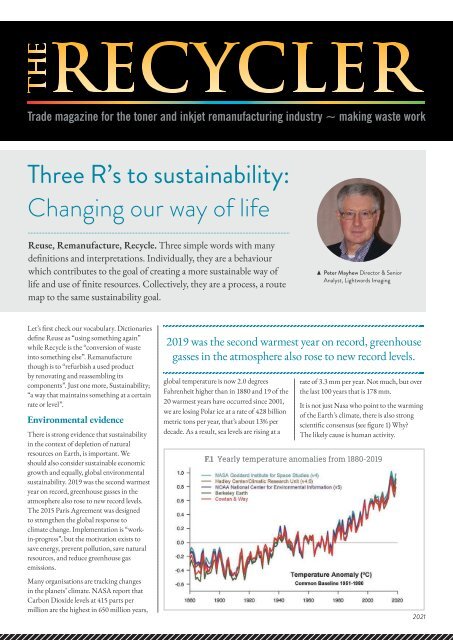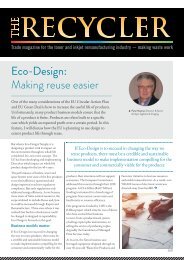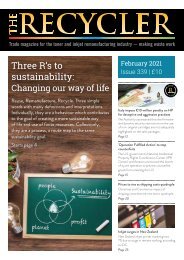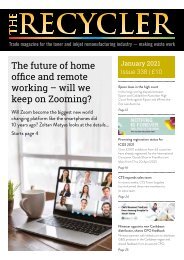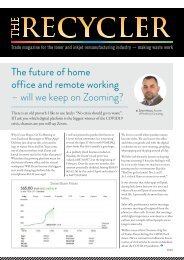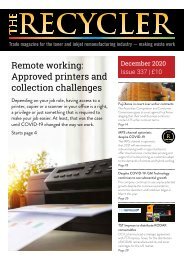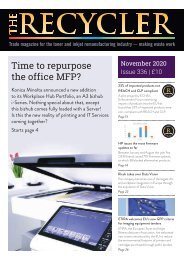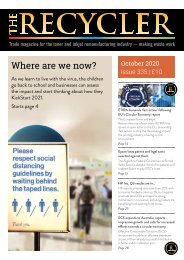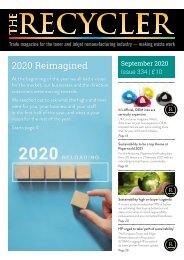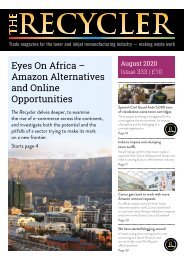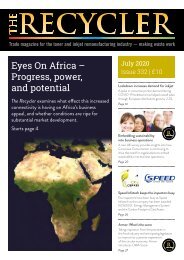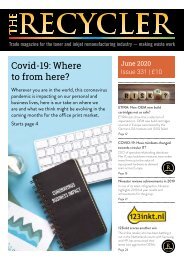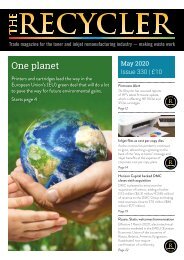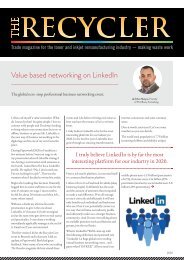The Recycler - Three Rs
You also want an ePaper? Increase the reach of your titles
YUMPU automatically turns print PDFs into web optimized ePapers that Google loves.
<strong>Three</strong> R’s to sustainability:<br />
Changing our way of life<br />
Reuse, Remanufacture, Recycle. <strong>Three</strong> simple words with many<br />
definitions and interpretations. Individually, they are a behaviour<br />
which contributes to the goal of creating a more sustainable way of<br />
life and use of finite resources. Collectively, they are a process, a route<br />
map to the same sustainability goal.<br />
▲ Peter Mayhew Director & Senior<br />
Analyst, Lightwords Imaging<br />
Let’s first check our vocabulary. Dictionaries<br />
define Reuse as “using something again”<br />
while Recycle is the “conversion of waste<br />
into something else”. Remanufacture<br />
though is to “refurbish a used product<br />
by renovating and reassembling its<br />
components”. Just one more, Sustainability;<br />
“a way that maintains something at a certain<br />
rate or level”.<br />
Environmental evidence<br />
<strong>The</strong>re is strong evidence that sustainability<br />
in the context of depletion of natural<br />
resources on Earth, is important. We<br />
should also consider sustainable economic<br />
growth and equally, global environmental<br />
sustainability. 2019 was the second warmest<br />
year on record, greenhouse gasses in the<br />
atmosphere also rose to new record levels.<br />
<strong>The</strong> 2015 Paris Agreement was designed<br />
to strengthen the global response to<br />
climate change. Implementation is “workin-progress”,<br />
but the motivation exists to<br />
save energy, prevent pollution, save natural<br />
resources, and reduce greenhouse gas<br />
emissions.<br />
Many organisations are tracking changes<br />
in the planets’ climate. NASA report that<br />
Carbon Dioxide levels at 415 parts per<br />
million are the highest in 650 million years,<br />
2019 was the second warmest year on record, greenhouse<br />
gasses in the atmosphere also rose to new record levels.<br />
global temperature is now 2.0 degrees<br />
Fahrenheit higher than in 1880 and 19 of the<br />
20 warmest years have occurred since 2001,<br />
we are losing Polar ice at a rate of 428 billion<br />
metric tons per year, that’s about 13% per<br />
decade. As a result, sea levels are rising at a<br />
rate of 3.3 mm per year. Not much, but over<br />
the last 100 years that is 178 mm.<br />
It is not just Nasa who point to the warming<br />
of the Earth’s climate, there is also strong<br />
scientific consensus (see figure 1) Why?<br />
<strong>The</strong> likely cause is human activity.<br />
F.1 Yearly temperature anomalies from 1880-2019<br />
2021
Change for the better<br />
Changing human behaviour is not easy.<br />
Psychologists cite the Fogg Behaviour Model<br />
which identifies behaviour as composed of<br />
motivation, ability, and triggers. When all<br />
three occur in the correct sequence, change<br />
is most likely to occur.<br />
Governments role is critical in setting<br />
agenda’s which lead to behavioural change.<br />
<strong>The</strong> European Union recognises this<br />
responsibility through its EU Circular<br />
Action Plan and EU Green Deal. A package<br />
of legislative and non-legislative measures<br />
and actions the EU can take to add value<br />
and provide a roadmap to achieving climate<br />
neutrality in the region.<br />
<strong>The</strong>ir scope is broad, considering the entire<br />
life cycle of products including design,<br />
manufacture, consumption, repair, reuse,<br />
recycling and returning resources back<br />
to the environment and economy. <strong>The</strong>y<br />
contain specific targets including, doubling<br />
circular material use in a decade. <strong>The</strong> EU<br />
estimates that these initiatives will increase<br />
its GDP by 0.5% by 2030 and create<br />
700,000 jobs.<br />
Specifically, the Action Plan and Green<br />
Deal will look at Eco-Design reaching<br />
beyond energy savings into product<br />
sustainability, right to repair, durability,<br />
reusability, upgradability, repairability<br />
and waste. <strong>The</strong> use of hazardous chemicals<br />
also falls within their scope. <strong>The</strong>ir target<br />
Waste Electrical and Electronic Equipment<br />
is one of the largest sustainability problems<br />
facing the planet.<br />
markets include Electronics, Information<br />
and Communications Technology, Textiles,<br />
Plastics, Construction and Buildings,<br />
Packaging, Batteries, Vehicles and Food.<br />
Waste is a huge problem for the EU.<br />
<strong>The</strong> plan and deal address waste creation,<br />
target setting, extending producer<br />
responsibilities, and restricting exports.<br />
To achieve its goals the EU has put in place<br />
supporting funds, financing, a Circular<br />
Economy Alliance, monitoring frameworks<br />
and indicators. <strong>The</strong> EU estimates that<br />
over €500 billion ($615 billion) will be<br />
invested over the next 10 years in the “green<br />
economy” but, some money is re-allocated<br />
existing budgets and expenditure.<br />
One initiative is the €80 billion ($98<br />
billion), EU Horizon 2020 Research<br />
and Innovation Program which aims to<br />
encourage a package of eco-innovative<br />
services. It is an initiative leveraged by<br />
Lexmark through its C-Servees Project.<br />
C-Servees is a consortium of industries<br />
and academia sharing best practice and<br />
boosting the shared use, reuse, repair and<br />
remanufacture of products through their<br />
eco-design and implementation of productservice<br />
systems. Updating <strong>The</strong> <strong>Recycler</strong> on<br />
the status of the project Lexmark’s Head<br />
of Government Affairs EMEA, Maxime<br />
Furkel said: ”<strong>The</strong> project has now passed<br />
the half way stage and the exchange of ideas<br />
and cooperation from engineers, suppliers<br />
and life cycle experts from a wide range of<br />
diverse industries have been very beneficial<br />
for Lexmark.”<br />
However you consume your news make sure you engage: Like, Follow and Share
<strong>The</strong> impact of WEEE<br />
and WEEE2<br />
Waste Electrical and Electronic Equipment<br />
is one of the largest sustainability problems<br />
facing the planet. In 2006 most EU states<br />
transposed the WEEE Directive and<br />
regulations into law. <strong>The</strong> regulations<br />
separated WEEE into two categories; first<br />
is WEEE placed on the market before<br />
2005 where the onus is on the owner to<br />
manage its recycling and second, WEEE<br />
produced later, where the producer and/or<br />
distributor has the collection and recycling<br />
responsibility.<br />
<strong>The</strong> 2014 WEEE 2 directive laid down<br />
certification criteria to demonstrate<br />
that companies are complying with the<br />
regulations. <strong>The</strong>se regulations provide<br />
frameworks for how end-of-use products<br />
are managed at the end of their lifecycle.<br />
<strong>The</strong>y also encourage recycling and reuse.<br />
<strong>The</strong> scope encompassing everything from<br />
household appliances to IT equipment<br />
to medical devices. Certification is now<br />
mandatory for many electronic devices.<br />
Non-compliance could result in an<br />
EU wide market bar. Pollution of the<br />
environment carries significant fines.<br />
<strong>The</strong>re are numerous takeback schemes<br />
in action today which vary depending<br />
upon whether we are discussing business<br />
or consumer WEEE. Revenue streams<br />
accompanying the WEEE also vary<br />
between B2B and B2C channels and EU<br />
countries. <strong>The</strong> B2C advice if the product<br />
features the WEEE symbol (see figure 2) is<br />
to check with the local authority, product<br />
manufacturer and distributor to establish<br />
the correct collection channel. In a B2B<br />
scenario, do not expect to take it to the<br />
local household recycling center, they are<br />
likely to turn you away.<br />
F.2 WEEE Symbol<br />
F.3 China Consumers Electronics Replacement Habits<br />
China has the lowest percentage of consumers replacing devices less frequently<br />
but the highest number of consumers who plan to implement<br />
100%<br />
75%<br />
50%<br />
25%<br />
0%<br />
US China India Germany<br />
Already replacing<br />
less frequently<br />
Letting go: Reuse in the<br />
ICT sector<br />
Some electronic products have a value that<br />
cannot be measured in financial terms only.<br />
Humans develop emotional attachments<br />
which means we habitually store products<br />
at the end of their life, rather than return or<br />
dispose of them into the WEEE stream.<br />
A study by Alphawise, the proprietary<br />
survey and data arm of Morgan Stanley<br />
Research found that almost 50% of<br />
consumers keep electronic devices that have<br />
stopped working. <strong>The</strong> study also found<br />
that trade-in and recycling is on the rise in<br />
the consumer market and, that almost 80%<br />
of respondents intend to either repair or,<br />
have repaired their devices in the next two<br />
years. A consequence is that consumers are<br />
extending the lifetime of devices and, 60%<br />
are buying new devices less frequently.<br />
<strong>The</strong> repair or replace conundrum<br />
varies around the world. Figure 3 shows<br />
consumers in China have been behind in<br />
replacing their devices less frequently than<br />
others but, 90% of Chinese respondents<br />
plan to slow their rate of replacement.<br />
Finally, the Alphawise study revealed<br />
that cash remains the greatest incentive<br />
to encourage consumers to trade-in. It is<br />
estimated that there are billions of Euros of<br />
older, serviceable mobile phones in homes.<br />
Most manufacturers offer a generous<br />
trade-in against new models but take-back<br />
is low. A quick and unscientific study of the<br />
Planning to replace<br />
less frequently<br />
UK<br />
No plans<br />
Source: Alphawise, Morgan Stanley Research<br />
author’s own home embarrassingly found<br />
four, old but usable mobiles.<br />
Getting this waste into reuse by<br />
remanufacturing before recycling is a<br />
problem. Numerous surveys demonstrate<br />
that consumers want to rethink their<br />
behaviour in a more sustainable way. One<br />
survey by Capgemini revealed that 79% of<br />
German buyers are ready to change.<br />
But how? <strong>The</strong> answer may come from<br />
an unlikely source, Value Added Tax<br />
(VAT). It has been suggested by several<br />
environmental groups including the Green<br />
Alliance, that reducing VAT on repairs<br />
would keep products in use for longer and<br />
create employment. Evidence from several<br />
EU country trials found encouraging<br />
results. In Sweden, when they reduced<br />
repair VAT, they countered the lost revenue<br />
with an increased tax on hazardous waste.<br />
It is possible that the problem is broader<br />
than motivation to reuse or recycle.<br />
Economically, there is a need to separate<br />
the use of resources from economic growth<br />
and, to separate environmental impact from<br />
resource use. But these are social norms<br />
which may take regional, and probably<br />
global events to spark change.<br />
Measuring progress is important and the<br />
EU has a target of collecting 65% of WEEE<br />
placed on the market. A target missed by<br />
the UK and many other member states in<br />
2018. Even defining the collection goals in<br />
measurable tonnage terms has been difficult<br />
to achieve.<br />
However you consume your news make sure you engage: Like, Follow and Share
Rare metals and toxic WEEE<br />
Another incentive to recover WEEE is the<br />
quantity of precious metals it contains.<br />
E-waste such as laptops, mobile phones and<br />
monitors contain some of the Earths rarest<br />
natural resources, Gold, Neodymium and<br />
Indium. Although combined they account<br />
for 0.00001% of this planets crust, they<br />
play a critical role in the connectivity and<br />
displays of devices.<br />
Neodymium and indium are not only rare,<br />
but they are only found in certain parts<br />
of the world where the supply chains are<br />
insecure. This makes their recovery from<br />
waste more critical. Recovery is feasible,<br />
but not straight forward. <strong>The</strong> ecological<br />
A consequence is that consumers are extending<br />
the lifetime of devices and, 60% are buying new<br />
devices less frequently.<br />
case for recovering Neodymium is clear;<br />
when the material is obtained from a<br />
recycling process the overhead on the<br />
environment is a third less than if it were<br />
mined from the earth.<br />
Recovering Indium from disassembled<br />
LCD screens is similarly worth the effort.<br />
However, the quantities involved are<br />
small both in devices and in the world.<br />
Consequently, their monetary value is low<br />
making the recovery process economically<br />
questionable.<br />
Shipping older devices from developed to<br />
developing markets may be sustainably<br />
problematic. From a reuse perspective,<br />
the life of the product is extended but,<br />
the environmental cost of transportation<br />
needs to be considered. Further, at end of<br />
life, disposal in some countries is as crude<br />
as open burning of the waste.<br />
A substantial proportion of WEEE is<br />
plastic and the burning process releases<br />
both useful energy and harmful gasses<br />
to the atmosphere. Energy recovery and<br />
emission treatment is essential to the<br />
sustainability argument. It also makes<br />
sense to keep devices with high content<br />
in use and functioning rather than losing<br />
these resources to bottom ash (residual<br />
waste from the energy-from-waste<br />
processes) or landfill forever.<br />
However you consume your news make sure you engage: Like, Follow and Share
<strong>The</strong> document<br />
printing market<br />
If you review the websites of the<br />
major industry OEMs you will find<br />
manufacturers are trying to produce in a<br />
sustainable manner. Most have invested in<br />
“green” factories with measurable energy<br />
efficiency and emissions control gains.<br />
Some take important steps to ensure that<br />
the products they produce are collected and<br />
disposed of in a responsible manner.<br />
For example, Canon has collected and<br />
recycled 408,000 tonnes of cartridges in a<br />
28-year period to 2018. To acknowledge<br />
reuse, Canon has also reduced its reliance<br />
on new materials by 285,000 tonnes.<br />
Ricoh in Japan apparently collects 115,000<br />
machines from across the region. And<br />
Epson claims the 50 million units sold of<br />
its eco-tank printers has saved a “potential”<br />
1.1 million tonnes of plastic based<br />
consumables.<br />
It is in reuse and remanufacturing where<br />
the aftermarket excels. <strong>The</strong>re may be<br />
high expectations that a recent European<br />
Voluntary Agreement initiative may help<br />
to reinforce the “remanufacturing”<br />
element of the printing supplies<br />
aftermarket but, “voluntary” may not be<br />
A substantial proportion of WEEE is plastic and<br />
the burning process releases both useful energy<br />
and harmful gasses to the atmosphere.<br />
sufficient or timely enough to comply<br />
with the mood in Brussels.<br />
Late in November 2020, European MEP’s<br />
voted positively for a resolution which calls<br />
on the European Commission to make it<br />
easier for consumers to repair, resell and<br />
reuse products, specifically to improve<br />
sustainability. <strong>The</strong>y want to tackle activities<br />
which shorten the life of products, an area<br />
where the document printing market has a<br />
questionable reputation.<br />
This positive decision may also be good<br />
news for ETIRA President, Javier Martinez<br />
who, in a pre-vote interview, commented<br />
that he would like to see “Proper<br />
Regulation” of the document printing<br />
industry. He went further to say that he<br />
would like to see “WEEE, ROHS and<br />
product compliance regulations enforced.”<br />
<strong>The</strong> COVID-19 pandemic of 2020<br />
has caused the world to unite and fight<br />
a common viral problem. <strong>The</strong> global<br />
reaction has had both positive and negative<br />
outcomes. One positive effect has been<br />
that of reducing human activity and<br />
consequently emissions of greenhouse<br />
gasses have fallen. However, the rate at<br />
which humans are using technology has<br />
accelerated, advancing its penetration into<br />
all aspects of life by several years, causing<br />
demand for devices to increase.<br />
<strong>The</strong> most positive consequence has<br />
been that environmental awareness has<br />
been heightened and environmental<br />
sustainability strategies and policies are<br />
now seen as a viable method of creating<br />
economic growth and employment.<br />
<strong>The</strong> opportunity now exists for reuse,<br />
remanufacturing and recycling to become<br />
mainstream activities and permanently<br />
embed themselves in the document<br />
printing industry. ■<br />
However you consume your news make sure you engage: Like, Follow and Share


